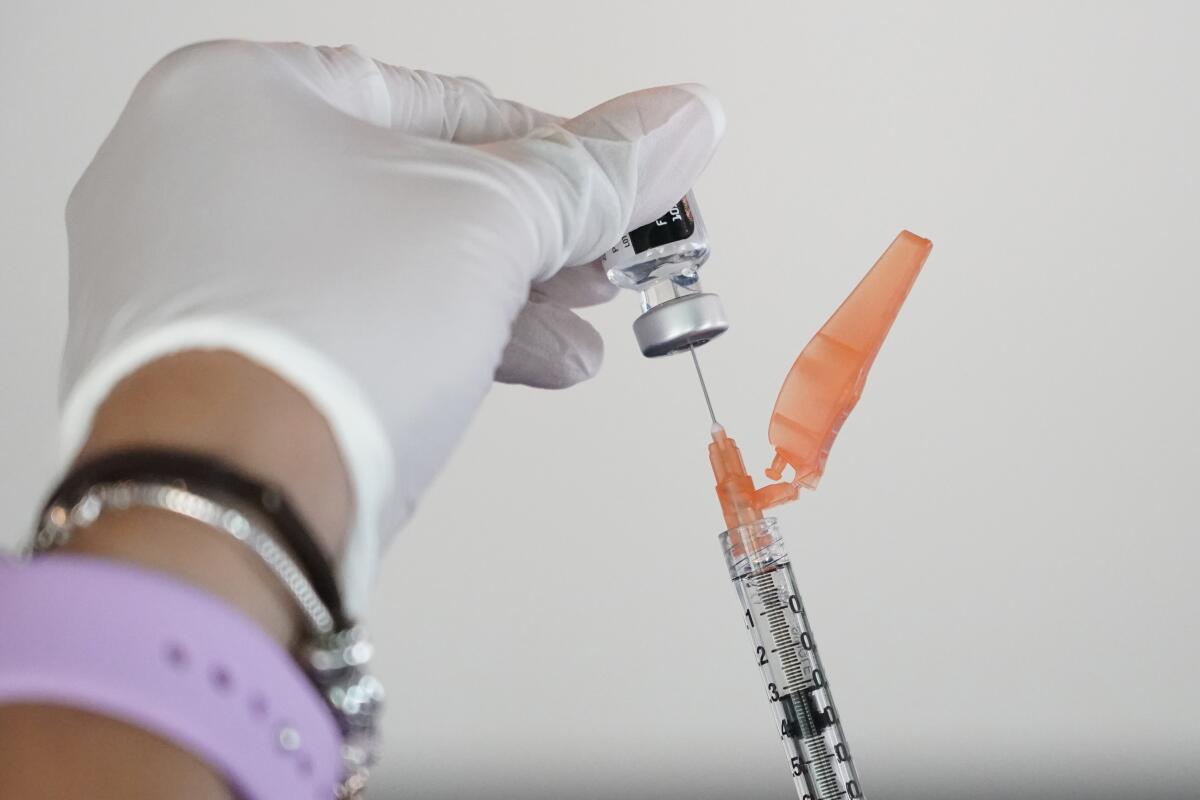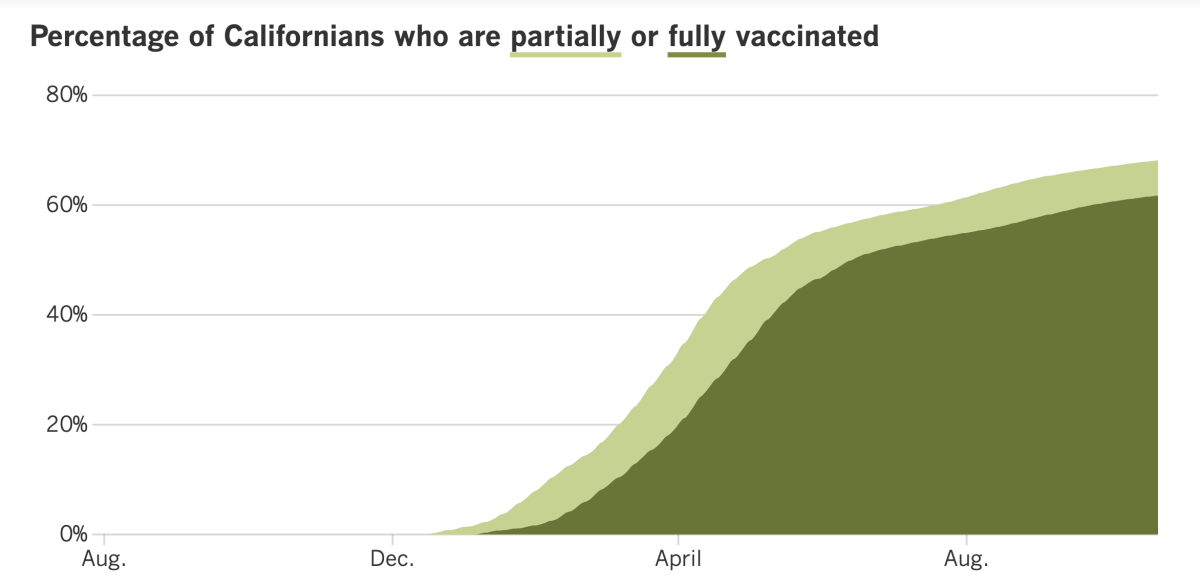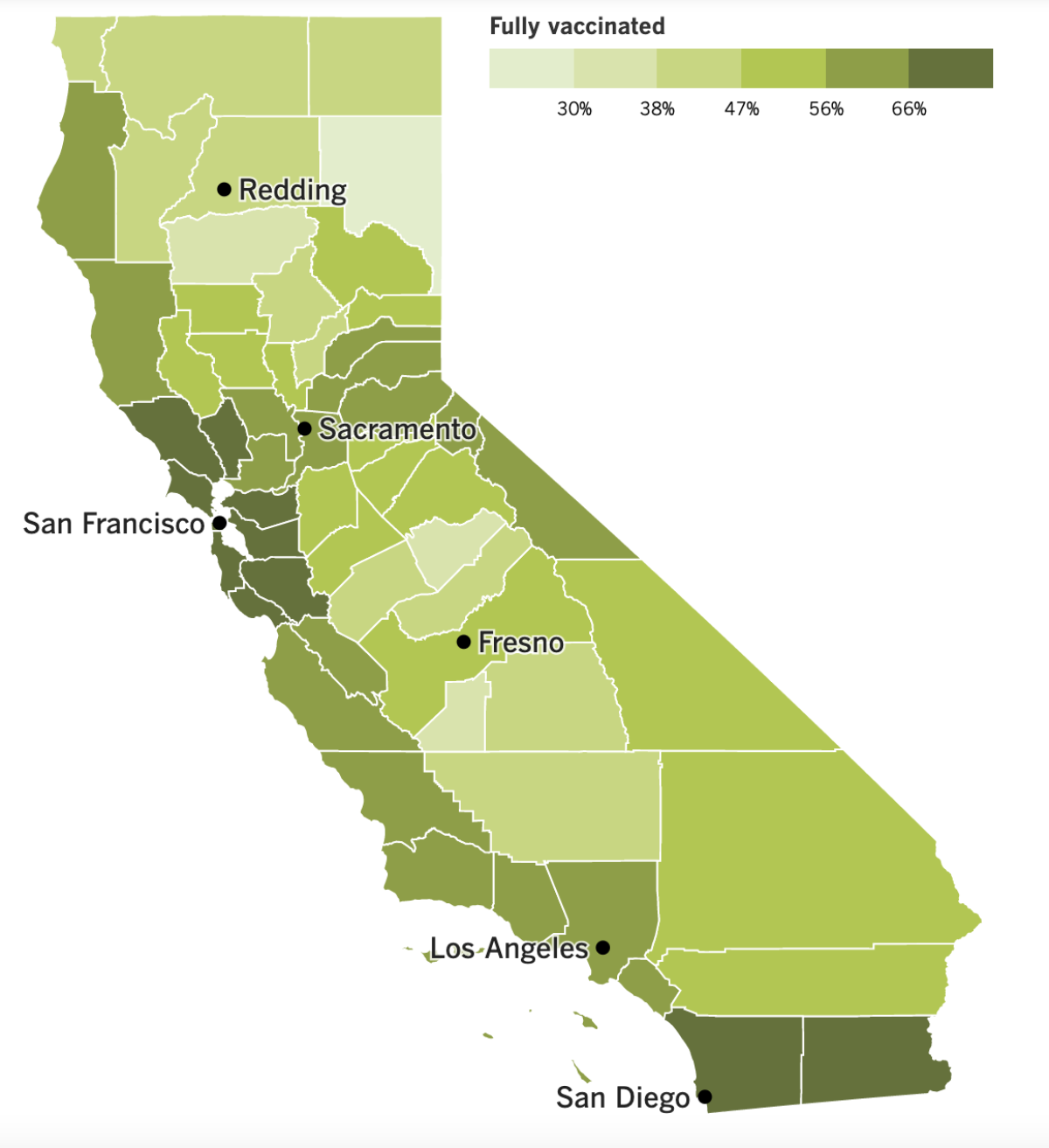Coronavirus Today: In-N-Out vs. San Francisco
Good evening. I’m Karen Kaplan, and it’s Friday, Oct. 22. Here’s the latest on what’s happening with the coronavirus in California and beyond.
In-N-Out has been serving hamburgers since 1948. That’s the business it knows. But now San Francisco wants it to add some light law enforcement to the menu — and the restaurant chain is not happy about it.
How unhappy? In-N-Out would rather let health inspectors close its Fisherman’s Wharf location than make customers show picture ID and proof of COVID-19 vaccination.
“As a company, In-N-Out Burger strongly believes in the highest form of customer service and to us that means serving all customers who visit us and making all customers feel welcome,” said Arnie Wensinger, the chain’s chief legal and business officer. “We refuse to become the vaccination police for any government.”
In-N-Out was willing to put up signs informing patrons that, in San Francisco, diners were required to show proof of vaccination if they wanted to eat indoors. Those signs were “properly and clearly” posted, Wensinger said.
But actually asking for that documentation — let alone turning away customers who lacked it — would be going too far.
“We fiercely disagree with any government dictate that forces a private company to discriminate against customers who choose to patronize their business,” the attorney said in a statement.

That’s one way to look at it. Here’s another: COVID-19 is a contagious respiratory disease that has killed more than 70,000 Californians and more than 733,000 Americans.
COVID-19 vaccines are the way to turn that around — and the more, the better.
“Vaccines remain our best tool to fight this disease and come out of the pandemic,” said the San Francisco Department of Public Health, which shut down the In-N-Out. “Vaccination is particularly important in a public indoor setting where groups of people are gathering and removing their masks, factors that make it easier for the virus to spread. That is why San Francisco requires proof of vaccination for indoor dining.”
Many restaurant operators in the city seem to agree. Nearly 4 out of 5 food-service businesses polled by the Golden Gate Restaurant Assn. said asking customers to show proof of vaccination before serving them indoors was actually pretty easy.
“Does it put a burden on you? Do you have to add a little more staffing? Does it put people potentially in conflict? Unfortunately, it does,” Laurie Thomas, the group’s executive director, told my colleagues. “But, really, it has been much less of a problem than anybody anticipated.”
In Los Angeles County, restaurants are encouraged to ask customers dining indoors for proof of vaccination, but it’s not strictly required. On Nov. 8, restaurants in L.A. city limits will be subject to a rule like the one in San Francisco. (The city ordinance will also apply to gyms, stores, movie theaters and other indoor venues.)
The San Francisco health department says In-N-Out has “taken steps to comply” with its rules and is once again serving customers at Fisherman’s Wharf — for outdoor seating or takeout only.
By the numbers
California cases and deaths as of 3:30 p.m. Friday:

Track California’s coronavirus spread and vaccination efforts — including the latest numbers and how they break down — with our graphics.
A coronavirus conundrum
Imagine it were up to you to decide whether to give someone a COVID-19 booster shot. You’d probably want to know how much immunity that person already had so that you didn’t subject them to an unnecessary needle stick (and the small risk of adverse effects that come with it). That information would also ensure that you didn’t withhold a shot from someone who needed it.
This is hardly a radical concept. Doctors only prescribe statin drugs to people after a blood test shows they have high cholesterol. Likewise, no one will ask you to inject yourself with insulin unless you have a bona fide case of diabetes.
The problem with COVID-19 boosters is that scientists haven’t come up with a way to test whether a person’s vaccine protection has worn off. It might take years for them to find one — assuming they ever do.
There’s no question that some people need booster shots. Plenty of data from the real world show that vaccine protection is waning, especially when it comes to their ability to prevent mild and moderate illness.
But seeing a need for boosters in general is not the same as figuring out when a particular individual should get an extra shot in the arm. To do that, scientists need “a common currency by which people’s levels of protection can be reliably measured, valued and compared,” my colleague Melissa Healy explains. “If it rises, that means a person’s defenses are stronger; if it falls, they’ve become more vulnerable.”
The ideal candidate would be easy to measure (no biopsies, please) with a test that produces accurate results and doesn’t break the bank. If the test results fall below a certain threshold, you’d know a booster shot was in order.
Right now, coronavirus antibodies are the closest thing we have. Their levels rise right after a dose of vaccine (or a true infection) and then decay over time. But we know that’s not the whole story.

Even after antibody levels wane, the immune system still protects with so-called memory cells like B cells and T cells. Unfortunately, it’s unclear how memory cells are correlated with the overall strength of the immune system’s ability to fend off the coronavirus.
And then there are lymph nodes, white blood cells and other things in the mix. Their relative importance can shift over time, so your test results might change even though your immune protection doesn’t.
In the midst of all this complexity, finding one single thing to measure is like playing “three-dimensional chess,” said Dr. Archana Chatterjee, a pediatric infectious disease expert at the University of Chicago who serves on a panel that advises the Food and Drug Administration about vaccines.
Indeed, several members of that advisory panel lamented the lack of a coronavirus immunity metric as they debated whether to recommend COVID-19 booster shots.
It’s “one of the struggles we’re all having,” said Dr. Hayley Gans, a pediatric infectious disease specialist at Stanford University.
California’s vaccination progress


See the latest on California’s vaccination progress with our tracker.
Your support helps us deliver the news that matters most.
In other news ...
Are you tired of COVID-19 vaccines yet? No? Good, because more of them are on the way.
The number of Americans eligible for booster shots has increased by millions now that the FDA and Centers for Disease Control and Prevention have signed off on extra doses for people who got the Moderna or Johnson & Johnson vaccines the first time around.
The guidelines for Moderna folks are the same as for people who got the Pfizer-BioNTech vaccine: They are advised to get it if they are at least 65 years old, if they live in a nursing home or similar group setting, or if they’re at increased risk of becoming severely ill with COVID-19 because of a preexisting health problem.
In addition, booster shots are available to adults of any age if they’re at increased risk of COVID-19 because of their health, their living situation or their jobs. That last category covers people like healthcare workers and teachers.
The Moderna booster shots contain half the dose used in the primary series. To be eligible, the second dose must have been given at least six months earlier.
The advice is different for those who got the J&J vaccine: Everyone in that group is advised to get a booster if they got their initial jab at least two months ago. The single-dose vaccine has not offered as much protection as the two-dose options, but adding a booster after a shorter delay will help make up the gap, advisors said.
And to add a little excitement for everyone, regulators will now allow people to “mix and match” their booster shots, so they can switch to another brand if they’d like. Not having to track down a specific type of shot should make the process more convenient, officials said.
There are other reasons to consider a mix-and-match booster too. For instance, younger women who got the J&J vaccine the first time around might opt for one of the mRNA vaccines as a booster to avoid the small risk of a rare blood-clotting disorder, a problem that prompted regulators to “pause” the use of that vaccine for 10 days this spring. Similarly, younger men who started out with an mRNA vaccine might want to switch to the J&J shot to avoid a small risk of myocarditis, an inflammation of the heart muscle.
A government-sponsored study on the potential benefits of different combinations is ongoing, and preliminary data suggest people vaccinated with the Johnson & Johnson shot produced more coronavirus-fighting antibodies when they were boosted with the Pfizer or Moderna vaccines. That prompted some members of the CDC’s vaccine advisory panel to suggest that J&J recipients switch brands for their booster.
Next week, an FDA advisory panel will examine data on Pfizer’s vaccine for children ages 5 to 11. On Friday, the company said its clinical trial showed the vaccine was safe and that it reduced the risk of developing COVID-19 by 91%.
Pfizer tested kid-sized doses that were one-third the size of doses given to teens and adults. The trial involved nearly 2,300 children and was conducted during August and September, when the Delta variant was the dominant coronavirus strain.
The company said there were three cases of COVID-19 among the children who were randomly selected to get the vaccine and 16 cases among those who got a placebo.
In addition, Pfizer said the smaller dose prompted an antibody response in young children that was equivalent to the response seen in teens and adults who received the full-strength shots.
If the vaccine is authorized for this age group — something experts consider likely — roughly 28 million additional children would be eligible for immunization sometime in November. The shots are packaged in vials with orange caps so they won’t be mistaken for the adult version.
The Biden administration is already making plans for the rollout. Once an emergency use authorization comes through, the shots will be available in more than 25,000 pediatricians’ offices, tens of thousands of pharmacies and possibly even at schools, according to the White House.
The special vials will be ready to ship within hours of authorization, along with smaller needles to administer the vaccine. About 15 million doses are expected to be distributed during the first week.
“We’re going to be ready, pending the FDA and CDC decision,” White House COVID-19 coordinator Jeff Zients said Wednesday.
Doctors are already bracing for a tsunami of patients.
“Judging by the number of calls, I think we’re going to be slammed for the first several weeks,” said Dr. Sterling Ransone, who has a practice in Deltaville, Va., and serves as president of the American Academy of Family Physicians.
And finally, here’s some fresh evidence that all the fuss is worth it: Two new studies show that the Pfizer-BioNTech vaccine works well in teens in real-world conditions.
The clinical trials that tested the vaccine in teens were conducted before the Delta variant became the dominant strain. Since Delta spreads more readily than its predecessors, there were questions about its effectiveness.
One report, published in the New England Journal of Medicine, found that the vaccine was 90% effective at reducing the risk of coronavirus infections one to three weeks after the second dose. It was also 93% effective at reducing the risk of developing COVID-19 symptoms.
The second report, published by the CDC, concluded that the vaccine reduced teens’ risk of being hospitalized for COVID-19 by 93%. The study identified 77 patients who were treated in the intensive care unit, including two who died. None of the ICU patients had been vaccinated.
The study “reinforces the importance of vaccination to protect U.S. youths against severe COVID-19,” the authors wrote.
Your questions answered
Today’s question comes from readers who want to know: Will we have to worry about coronavirus variants forever?
If not forever, then for a long, long time.
It is the nature of viruses to mutate — every time they copy themselves inside an infected person, there’s a chance to make a mistake with the genetic code. A mistake that helps a virus survive is bound to spread.
More than half the world remains unvaccinated, so the coronavirus has plenty of opportunity ahead of it. But the more time that passes, the more a virus adapts to its host. That leaves fewer opportunities for big changes to occur.
“We’ve seen a stage of rapid evolution for the virus,” said Dr. Adam Lauring, a virus and infectious disease expert at the University of Michigan. “It’s been harvesting the low-hanging fruit, but there’s not an infinite number of things it can do.”
But it could still change enough to sneak past the antibodies produced by COVID-19 vaccines or left behind from a previous infection. If that’s the case, it would make sense to tweak the vaccine periodically, the way we do with flu shots.
We want to hear from you. Email us your coronavirus questions, and we’ll do our best to answer them. Wondering if your question’s already been answered? Check out our archive here.
The pandemic in pictures

Millions of Americans are still suffering the economic fallout from the pandemic, including roughly 10 million people who are behind on their rent. And with the expiration of eviction moratoriums, thousands of them are calling places like the Desert Moon Motel home.
The Desert Moon was built in the 1930s and sits about a dozen blocks from the glitz of downtown Las Vegas. My colleagues Kurtis Lee and Francine Orr got to know some of the folks who scrape together $57 a night to secure their spot there.
There are young adults struggling to establish themselves. There are families who were priced out of California. There are people who should be contemplating retirement but find themselves back at square one. They’re grateful to be sleeping in beds instead of their cars.
“Everyone deserves a roof over their head,” said Kelly Robson, the chief social services officer for a local nonprofit that works to get people off the streets. “People deserve dignity and respect.”
Resources
Need a vaccine? Keep in mind that supplies are limited, and getting one can be a challenge. Sign up for email updates, check your eligibility and, if you’re eligible, make an appointment where you live: City of Los Angeles | Los Angeles County | Kern County | Orange County | Riverside County | San Bernardino County | San Diego County | San Luis Obispo County | Santa Barbara County | Ventura County
Practice social distancing using these tips, and wear a mask or two.
Watch for symptoms such as fever, cough, shortness of breath, chills, shaking with chills, muscle pain, headache, sore throat and loss of taste or smell. Here’s what to look for and when.
Need to get tested? Here’s where you can in L.A. County and around California.
Americans are hurting in many ways. We have advice for helping kids cope, resources for people experiencing domestic abuse and a newsletter to help you make ends meet.
We’ve answered hundreds of readers’ questions. Explore them in our archive here.
For our most up-to-date coverage, visit our homepage and our Health section, get our breaking news alerts, and follow us on Twitter and Instagram.




